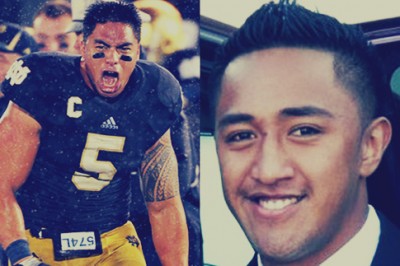NFC East
Dallas Cowboys: CB Byron Jones (No. 27)
Grade: B-
I didn’t see the quick hips and closing speed I would have liked from Jones. I can’t write him off without seeing more tape, though.
New York Giants: Ereck Flowers (No. 9)
Grade: B-
Flowers is a beast in the run game, but he might lack the agility to ever defend against good edge rushers effectively. #9 felt too high for a player who might end up at guard.
Philadelphia Eagles: WR Nelson Agholor (No. 20)
Grade: A
Agholor is quick in and out of breaks, sets up defenders, and has breakaway speed. He also sports very reliable hands and won contests for the ball. I’ll take that over Kevin White’s acrobatics any day.
Washington Redskins: OL Brandon Scherff (No. 5)
Grade: B+
I saw one media outlet describe Sherff as a “reach” while in the same breath touting Leonard Williams as the obvious pick here. Williams showed inconsistent effort for most of 2014; I’d venture Sherff has never played a down at anything less than top effort and commitment to technique. Who’s the “reach,” again? (By the way, with their talent at the skill positions and improvement up front, the Washington offense could make a little noise this year.)
NFC North
Chicago Bears: WR Kevin White (No. 7)
Grade: B
He’s good, I just liked other players better.
Detroit Lions: OG Laken Tomlinson (No. 28)
Grade: B
Most linemen I viewed as vastly superior to Tomlinson had come off the board by now, so I can’t hate the pick. But Detroit has a serious opportunity in this draft to restock its defensive line — where talent is a rarer commodity — with players like Jordan Philliips and Eddie Goldman available. They might regret letting that opportunity slip by.
Green Bay Packers: S Damarious Randall (No. 30)
Grade: B+
This team has two young starting safeties that can play the back end and roll up and cover a slot receiver man-to-man. If they want to rush 6 on passing downs, they’re probably free to do it. Sounds a little scary, right?
Minnesota Vikings: CB Trae Waynes (No. 11)
Grade: B+
I liked him, and he went high in the first round. No story here.
NFC South
Atlanta Falcons: LB/DE Vic Beasley (No. 8)
Grade: C+
Beasley struck fear in the hearts of college offensive tackles, okay? He’s lightning fast off the edge, and tackles looking to jump out and defend him often fell victim to agile pass rush moves back inside. I think he has heavy hands for a 225-pound player, too. So there’s potential. But NFL tackles will probably never stay awake at night over Beasley, largely because he doesn’t generate the power into them that makes speed so effective as a complement. The Seahawks apparently want none of Bruce Irvin just four years after drafting him; what makes us applaud Atlanta for taking a similar player in the Top 10?
Carolina Panthers: LB Shaq Thompson (No. 25)
Grade: A
This defense scares the daylights out of me.
New Orleans Saints: OL Andrus Peat (No. 13), LB Stephone Anthony (No. 31)
Grade: B-
Stephone Anthony plays fast and bullies players twice his size. Andrus Peat plays too high and gets bullied by players Anthony’s size. Mixed bag here. (By the way, not sure how many pundits ranked Stephone Anthony the highest inside linebacker in the draft, but yours truly did. Wasn’t the least bit surprised to see him go here.)
Tampa Bay Buccaneers: QB Jameis Winston (No. 1)
Grade: A
Jameis Winston is about as prepared to learn the position of NFL quarterback as almost anyone leaving college: good arm, good touch, toughness in the face of pressure, experience making pro-style reads. And not for nothin’: where else were the Bucs going to turn for a quarterback?
NFC West
Arizona Cardinals: OL D.J. Humphries (No. 24)
Grade: A+
Love this pick. Humphries compares favorably to Tyron Smith. ‘Nuff said.
St. Louis Rams: RB Todd Gurley (No. 10)
Grade: A
Best available player. (And weird to see St. Louis draft only once in the first round, right? Zing, DC!)
San Francisco 49ers: DL Arik Armstead (No. 17)
Grade: B
Just like Leonard Williams, whom I wrote about my AFC Grades, Armstead’s motor runs hot and cold. A gamble like that is much more forgivable at 17, but the 49ers may regret passing on superior talent on the offensive line or a player like Agholor.
Seattle Seahawks: No picks
Grade: Incomplete
They lost this pick as a penalty for that terrible play call at the end of the Super Bowl, right?


